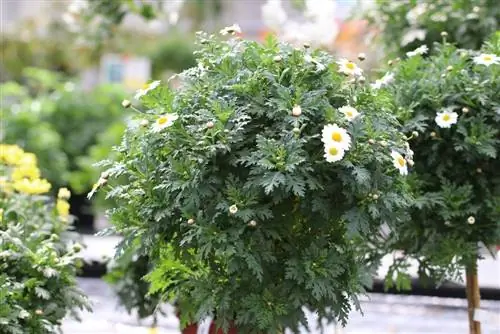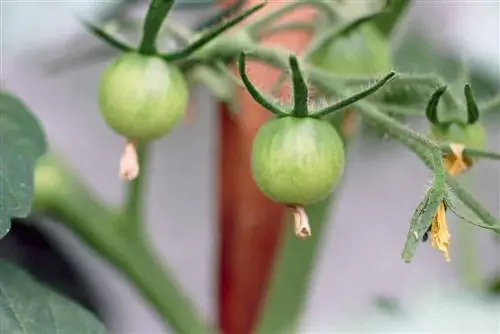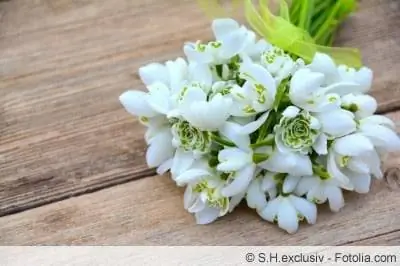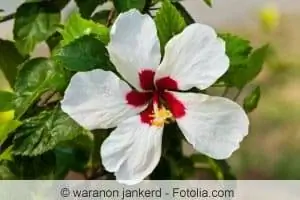- Author admin [email protected].
- Public 2023-12-17 03:39.
- Last modified 2025-01-24 12:45.
The daisy tree in the summer garden proudly boasts a colorful crown of pretty basket flowers. In contrast to the native meadow daisy, the opulent subshrub from the Canary Islands offers us the option of training it into a stem. In the pot, the opulent daisy tree decorates the summery balcony or greets visitors at the entrance to the house as a floral guardian. Its tropical origins, coupled with richly branched growth as a flowering shrub, require adequate care, which differs from the perennial daisy. Argyranthemum frutescens is nevertheless alien to lofty claims. Read everything you need to know about caring for the daisy stem here.
Location
If the conditions at the location are right, the distinctive daisy stem impresses with its continuous flowering period from May until the first frost. This exotic flower dream takes shape particularly where the floral gem finds a microclimate that resembles the native islands of eternal spring. In these places a daisy tree shows its most beautiful side:
- Full sunny location with 4 to 6 hours of sunshine daily
- Sunny to partially shaded locations reduce the abundance of flowers
- Temperatures between ideal 20 and maximum 35 degrees Celsius
- Preferably surrounded by air to protect against heat build-up in summer
Cultivated in a pot, the daisy stem best exudes its exotic charm on the south-facing balcony. If you want the flower-rich ornamental trees in the winter garden to reflect the flair of the Canary Islands, we recommend light shading during midday in summer.
Tip:
The higher the ideal temperature level of 20 degrees for a daisy tree is exceeded, the more noticeably shortened the flowering period is. A location in front of the south wall of the house is therefore disadvantageous.
Soil and substrate
If the daisy stem is not intended to overwinter, it likes to join the perennials in the summer garden. Choose a sunny location in the bed with nutrient-rich, humus-rich soil. The soil should be fresh and moist and have reliable drainage. Where the soil condition does not reach the desired quality, simply compensate for the deficiencies with additives. This gives compacted soil with sand and fine grit more permeability. You can optimize lean soil with compost, bark humus, horse manure and horn shavings.
Since a daisy tree cannot boast of winter hardiness, the vast majority of hobby gardeners prefer cultivation in a container. The ideal substrate consists of high-quality compost-based potting soil enriched with quartz sand, perlite respiration flakes or lava granules. A few handfuls of clay give an adult daisy in a pot more stability.
Plants in pots

In order to train the subshrub into a pretty daisy stem, it is an advantage to start as early in the year as possible. Plant a young bush daisy in a large pot with 5 to 10 liters of soil volume at the beginning/mid of April. The plant can spend warm spring days on the balcony and then be put away behind glass for the cold nights until mid-May. Potting and initial training measures for the standard tree go hand in hand. How to do it right:
- Create a drainage system made of potsherds or pebbles, covered with breathable fleece
- Fill the bucket a third full with substrate
- Soak the still potted young plant in water until no more air bubbles appear
- Then unpot and plant as deep as before in the cultivation container
- Place a sturdy support rod in the ground next to the plant
- Determine the strongest shoot on the trunk and connect it to the support rod
- Remove the shoots competing with the trunk and the lower side shoots
Fill the remaining potting soil into the bucket in portions, ensuring complete distribution. Cavities and air holes in the substrate significantly hinder rapid rooting. Please make sure to leave a pouring edge of 3 to 5 cm. It is poured with normal tap water.
Plants in the bed
The time window for planting a daisy tree in the bed doesn't open until mid-May. The cold-sensitive plant should not be exposed to the risks of delayed ground frosts. Loosen the soil deeply at the location and remove weeds, old roots and larger stones. While the potted root ball is soaked in water, dig a spacious planting pit. Mix the excavated material with compost, horn shavings and sand.
Plant the potted young plant including the support post so that the previous planting depth remains unchanged. After the soil has been pressed and watered, take the first training measures for the standard tree, similar to planting in a bucket.
Tip:
If you place a daisy stem and pot in the garden soil, it can easily be lifted out of the ground in autumn and left over the winter.
Pouring
In a warm, full sun location, a daisy tree continuously releases moisture through its dense crown. Regular watering compensates for the loss of water, which is rewarded with vigorous flowering. How to water the flowering tree properly:
- Check the substrate daily in the morning using a finger test
- If the surface is dry, run normal water directly onto the root disc
- Do not water daisy stems overhead
On hot summer days, it may be necessary to moisten the root ball again in the evening, especially in the pot. Again, the thumb test provides definitive information as to whether there is actually a need for watering. As long as you still feel moisture in the top 10 percent of the substrate, watering could lead to waterlogging, which the flowering bush rarely survives unscathed.
Fertilize
The supply of nutrients plays an important role in the successful care of daisies as stems. The dense flowers and leaves require a lot of energy from the plant. By continuously balancing consumption throughout the growth and flowering period, deficiency symptoms cannot affect the lavish appearance. How to fertilize properly in the garden and on the balcony:
- Add liquid fertilizer to the water in the bucket two to three times a week from April to September
- Water before and after with clear water
- Rake compost and horn shavings onto the surface of the bed weekly from May to September and water again
- Alternatively, apply a slow-release fertilizer in May and July according to the manufacturer's instructions
If you want to care for your daisy stem for several years, stop supplying nutrients in September. The shoots then mature, which has a beneficial effect on coping with the strenuous winter period.
Educational Cut

After you have initiated the cultivation of a daisy tree in connection with the planting, the measures continue during the summer and result in shape and maintenance pruning in the following years. This is how your daisy stem gets a harmonious spherical crown:
- Fix the trunk to the support rod in proportion to the growth
- Remove side shoots along the trunk and competing shoots
- When you reach the desired height, cut off the top of the shoot 4 pairs of leaves above the base of the crown
When you cut the shoot tip, you initiate the branching for crown formation. By consistently shortening all new side shoots down to 3 or 4 pairs of leaves, branching will continue unabated in these places. The result is a homogeneous, round shape, which is desirable for a daisy stem.
Shaping and maintenance pruning
So that a ready-made or home-grown daisy stem appears as if it had been peeled at all times, experienced hobby gardeners always have secateurs with them when they pay a visit to their gem. With these cutting measures you can achieve it:
- Clean out wilted flowers as soon as possible to make room for unopened buds
- If the abundance of flowers decreases in July/August, shorten all shoots by 3 to 5 cm
- Cut off all side shoots below the crown from the trunk
- Before putting away the crown, cut it back by about 50 percent
- Alternatively, prune at the end of winter
After wintering, thin out the crown of the daisy tree thoroughly. If necessary, trim the round shape slightly in April. By cutting each shoot individually and placing the scissors just above a bud or leaf node, you encourage further branching.
Wintering
Since your daisy stem is already shivering at temperatures around freezing point, it cannot overwinter in the open air. In the pot, the flower beauty is mobile enough to be moved behind glass in time for the onset of winter. This is how you overwinter bush marguerites in an exemplary manner:
- Stop giving fertilizer from September
- Only clear up when the temperature drops below freezing during the day
- The ideal winter quarters are bright and cool with 5 to 10 degrees Celsius
- Reduce watering water without causing bale dryness
Increased humidity makes your daisy tree comfortable in its winter quarters and keeps pests away. Therefore, spray the crown with soft water once or twice a week. Additionally fill the coaster with expanded clay and water, which optimizes the local humidity.
Tip:
If a daisy stem has fully rooted its pot, it is repotted into fresh soil after the winter break in March.
Propagate
When light and temperature conditions improve in April, this is an excellent date for propagation from cuttings. This relieves the budget and produces young bush daisies that transform into daisy stems that are just as magnificent as their mother plant. The ideal head cutting is he althy, 15 to 20 cm long and has no buds. In these steps, the offspring proceeds in a regulated manner:
- Defoliate the lower half of a cutting
- Fill small pots or a propagation box with a mix of potting soil and sand
- Pre-drill the planting hole for each cutting using the pricking rod
- Plant the shoot two thirds of its length and water it
- Equip cultivation pots with a transparent hood or plastic bag
- Put the lid on the propagation box
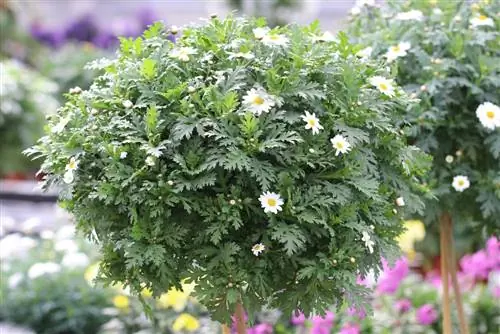
In a partially shaded, warm location, keep the substrate slightly moist, as drought stress represents the greatest risk to successful development. Fertilizer is not administered in this phase because rooting occurs more quickly in poor soil. A fresh shoot signals that roots are sprouting from a cutting, after which the cover can be removed. Wait until a strong root system has developed before repotting.
Diseases and pests
Leaf and shoot wilt (Verticillium)
If a daisy tree is exposed to heavy, wet soil, there is a risk of infestation with leaf and shoot wilt. This is a fungal infection that finds its way from the roots through the conductive pathways into the leaves and shoots. The supply lines then become clogged so that water and nutrients can no longer reach the crown. The result is wilted leaves and shoots. If you cut a branch open, it will be dark inside. How to fight the disease:
- Cut back all infected shoots down to the green tissue
- Thoroughly loosen the soil and make it more permeable with sand
- Repot the daisy stem if the pot is waterlogged
- Always only water when the substrate surface has dried
Check the nutrient supply at the same time. An excess of nitrogen is usually responsible for susceptibility. By immediately administering an organic fertilizer, such as compost or comfrey manure, you remove the pathogens' attack surface. Drainage against waterlogging and the use of peat-free soil have a preventive effect, as this tends to compact.
Aphids
The pretty pinnate leaves of a bush daisy are a popular target for aphids. Just in time for the start of the gardening season, the pests spread to the bottom and top surfaces. By piercing the tissue with their mouthparts and extracting the plant sap, the plant noticeably loses its vitality. Without countermeasures, the daisy tree will die. You can get rid of aphids with a simple home remedy. This is how it works:
- Cover the root disc in the bed with foil and pack the bucket in a plastic bag on the balcony
- Shower the crown with as strong a jet of water as possible
- Cut out severely affected shoots and dispose of them in household waste
After the crown has dried, the next stage of the ecological control strategy follows. Fill a hand sprayer with 1 liter of boiled water and add 1 tablespoon of soft soap. A splash of spirit increases the effectiveness of the home remedy. Spray the lower and upper sides of the leaflets at intervals of 2 days until no more aphids can be seen.
Spider mites
With the move to winter quarters, the risk of pest infestation is not averted. Now spider mites are lurking to extract the lifeblood from the leaves. White webs and speckled leaves signal the need for action, as the mites can multiply explosively. However, it is not necessary to resort to chemical insecticide, as these options are available to you in the early infestation stage:
- Always quarantine plants infected with spider mites
- From now on, spray the daisy tree daily with soft water
- Set up air humidifiers in the immediate vicinity
- Make a decoction from nettles, chopped onions and garlic cloves
- So that the affected marguerite is treated repeatedly
- Alternatively, pack the plant airtight in a transparent bag for 3 to 5 days
Specialist retailers offer effective remedies with natural ingredients for effective control. Best control successes are achieved with preparations based on rapeseed oil.
Conclusion
Lovingly cared for with the right care, the daisy stem makes a decorative contribution to the summer blossoms. The flower treasure from the Canary Islands takes pride of place in a sunny location with nutrient-rich, loose, humus-rich soil. Cultivation in a bucket is advantageous from several perspectives. Training to become a standard tree can be initiated early in the year as part of planting. The option of long-term care is also available, as mobility allows moving to winter quarters. Regular watering, repeated fertilization from April to August and consistent cleaning of withered flowers round off the care program. After a winter rest in a bright, cool location and a pruning, the daisy tree will once again impressively present itself next year with its flower-filled, round crown.

